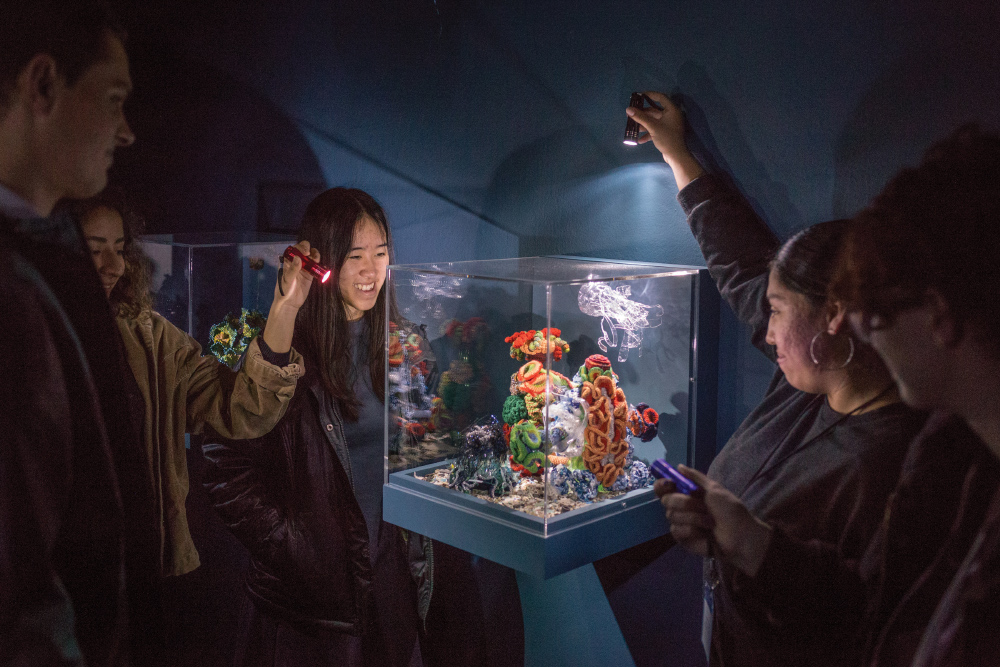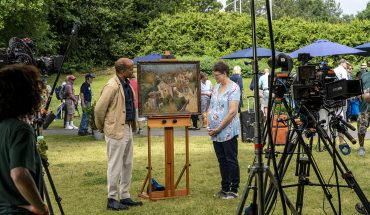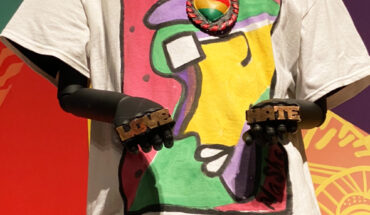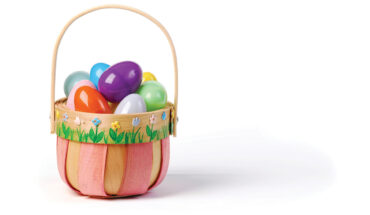Hundreds of hands created a piece titled Satellite Reef, which is partly composed of recycled and scrap materials.
by Hampton Williams Hofer
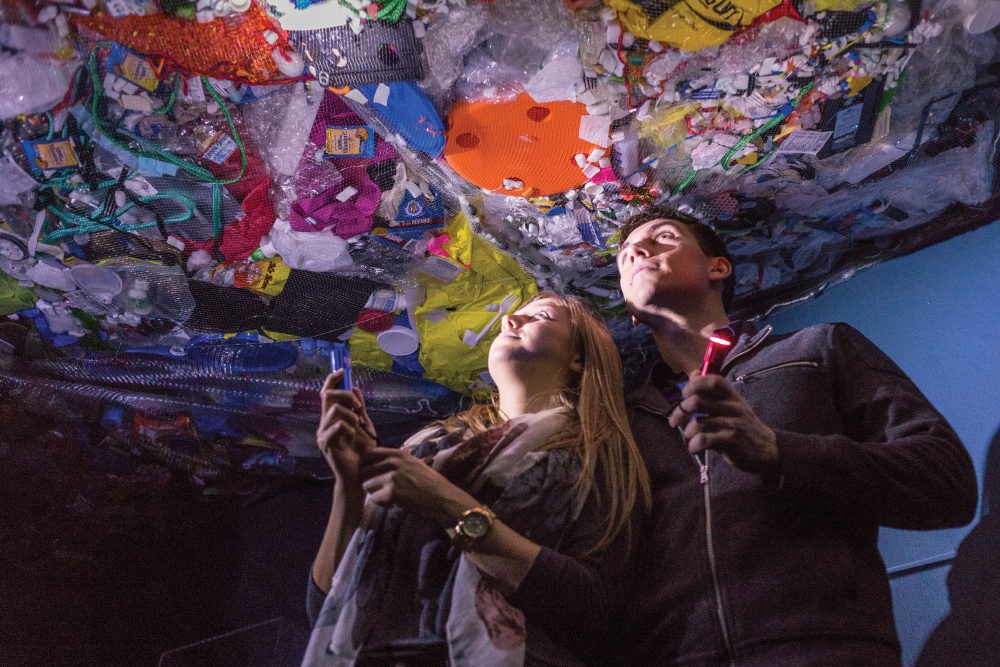
Crochet enthusiasts across the state have been working their hooks and strands since September to create a sweeping coral reef on display at the North Carolina Museum of Art this month. Colorful sponges, flowering seagrasses, and billowing jellyfish — made completely from crocheted materials — create this whimsical marine world, and an enormous wall label nearby boasts the names of more than 300 participants who brought it to life.
Angela Lombardi, director of audience engagement and outreach at the NCMA, cast a wide net when spearheading the creation of the North Carolina Satellite Reef. “We worked with yarn stores, local teachers, clubs, and college students,” she says. “An incredible level of community involvement was possible because the art form of crochet is so accessible.”
The Satellite Reef will sit at the entrance of a multimedia exhibition called Fault Lines: Art and the Environment, which explores humanity’s relationship to the earth. The crochet reef is in part composed of recycled and scrap materials. “We encouraged people to make plastic yarn out of grocery bags,” Lombardi says, “and we worked in partnership with North Carolina State University’s recycling center, which donated plastic film that could make yarn, keeping plastic out of the waste cycle.” Crochet yarn made from a Target bag? It’s not only possible, but fairly simple thanks to YouTube tutorials.
Launched as a response to the devastation of living reefs, the Satellite Reef is part of the Crochet Coral Reef project by the Institute For Figuring, a Los Angeles–based organization dedicated to the “poetic and aesthetic dimensions of science and mathematics.” Natural coral reefs offer endless diversity, and since living organisms are always irregular, participants in the project did not need to be crochet superstars. Whatever they wanted to create would work.
At the helm of the volunteer crochet effort was Linette Knight, who had worked with the artist Olek in 2017 for the large Nina Simone crocheted piece at the Convention Center. Knight grew up fascinated with coral reefs and is a longtime crochet enthusiast, so joining the creation of the Satellite Reef was a no-brainer for her. Knight had already produced billboard-sized crochet murals around the country when she came home to Raleigh, where she started a fence art project at John Chavis Memorial Park that was stalled by the pandemic. “I found out through friends about this coral reef project, and I was floored. It’s not easy to find community projects with crochet,” she says. Knight stepped up to teach classes both in-person and on Zoom — and they sold out, packed with sometimes 40 students at a time. She took it all in stride, relishing in the creative results from the chaos of teaching people with different skill levels. “It’s a passion thing for me,” she says.
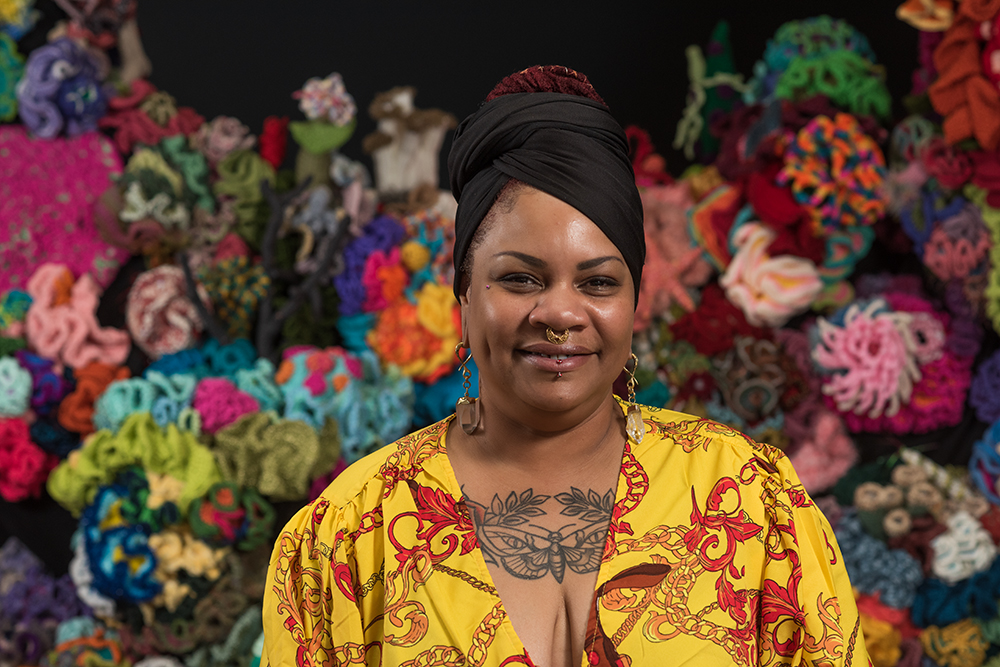
For Knight, who was born with three arthritic spikes on her back and suffers from pain and anxiety, the practice is a sort of meditation. “As you count the stitches, it helps to focus your mind on one thing, and the exercise was quite therapeutic for my hands,” she says. “I can sit anywhere, I can stand, I can travel with it, it’s a therapy for me, and I fell in love with everything I could create.”
“Creating a model of a ruffled form that happens in nature can be intimidating,” says Lombardi, “but when we put it into practice and had an artist like Linette teaching, people caught it right away.” The approachability of the project is a huge part of its success. The diversity of coral reefs themselves was reflected in the people who came together to create the Satellite Reef. Knight helped a vast array of participants on this project, from a 6-year-old girl learning basic stitches, to teenagers more experienced in making bracelets for their friends, to an 80-year-old woman. “This was something not confined to one demographic,” Lombardi says. “Across cultures and ages, we got a very broad swatch of community.”
When the NCMA took on the project, Lombardi had no plans to crochet anything. But after helping run the workshops, she learned almost accidentally. “Now I cannot watch TV without crocheting,” she laughs. Similarly, all of the members of the NCMA’s Teen Arts Council learned to crochet to support the program, and many reported back on how relaxing their new hobby was.
The timing of the reef’s creation during a pandemic actually strengthened community involvement, as so many people were at home, but still keen to be a part of something. Crochet was an easy skill to learn, and one that offered creative freedom. Some did basic stitches and crochet chains. Others created entirely new organisms. One participant crocheted exact replicas of real coral. “I said, You are an amazing artist,” Lombardi recalls, “and she said, No, I’m a pharmacist!”
Emily Howard, art education program coordinator at Meredith College, was excited to offer this project to her students. “We were able to participate on many levels by learning about the project through a workshop at the NCMA, and leading our own workshops at the North Carolina Art Education Association annual conference and Millbrook High School,” Howard says.
In the end, Lombardi received countless notes from contributors thanking her for the chance to be a part of something so meaningful. Knight recalls that one elderly woman broke down in tears when she learned that her work would be on exhibit at the NCMA. “She was so incredibly thankful for a project that showed that she could still be a part of something, could still use her fingers to crochet,” Knight says.
And that’s the point: the Satellite Reef is more than an homage to a miraculous marine world in need of our care — it’s a blend of creativity and community as awe-inspiring as the reef itself.
__
This article originally appeared in the April 2022 issue of WALTER magazine.

